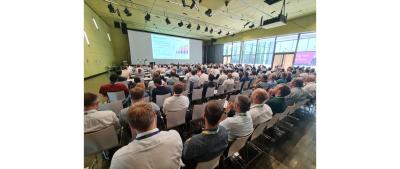The European Electronics Display Conference (edC), which takes place next week at Nuremberg, Germany, is a leading display conference, which takes part as part of the embedded world event. The conference focuses on industrial and automotive displays, and includes two days of keynote speeches and sessions.
MicroLEDs are featured at the conference, as the organizers realize the importance of the next-generation display technology. We had a short talk with the conference charimen Prof. Dr. Karlheinz Blankenbach from Pforzheim University's Display Lab.
Q: Thanks for taking the time to talk with us, Dr. Karlheinz. Can you tell us a bit about the Electronic Display Europe Conference?
The Electronic display Conference (edC) is an established conference held in Europe, that aims to promote the dialogue and discussion between engineers, researchers, users and manufacturers/distributors in the field of electronic displays and systems equipped with displays. This event is considered a must for display professionals in Europe and beyond. In June 2022, for example, more than 400 attendees and speakers came together at the event.
The speakers and the audience cover the whole value chain: decision makers, engineers and industry professionals. The traditional "Table-Top Author Interviews" scheme enables an intimate discussion with the speakers. Many highly valuable business contacts and projects have started at the events' networking breaks. A huge additional benefit is the “electronic displays area” of the embedded world exhibition, which runs in parallel to edC.
Q: What can display industry professionals expect from this year's event? We know that one of the sessions is dedicated to microLEDs, can you expand on that?
About 60 contributions, including 8 keynotes, provide highly valuable insights to display technologies, automotive topics, touch, system integration, outdoor applications and optical measurements to name a few. MicroLEDs are definitely the hottest topic, as this technology enables ultimate display performance for many applications. In the other sessions the attendees can compare today's technologies including their shortcomings with the potential of microLEDs.
Q: I understand that you feel that microLEDs are becoming more and more important. How do you see this emerging technology and industry?
MicroLEDs have the potential to improve most if not all of today's display applications by offering outstanding optical performance, lifetime and system integration. As is well known, the production and yields have room for improvements before wider commercialization can take place. This refers to mass transfer for larger displays and CMOS-microLEDs for micro-displays in AR/VR.
First products are already being shipped, like "The Wall" by Samsung (and a similar product from e.g. LG), and a 0.13" display from Jadebird (JBD) with VGA resolution. And, as you may know, there are many rumors about microLEDs in the future Apple Watch. So, microLEDs have started to conquer display applications from "both sides": Small CE and large professional displays. This opens the door to gaining experience in manufacturing and reducing costs in mid term. My personal view is that micro-displays made with microLEDs are superior to OLEDs by higher luminance/lifetime combination and no moving parts as laser beam scanning (LBS). Transparent displays can also profit from the higher transparency of microLEDs compared to OLEDs which is about a factor of two.
Q: edC is mostly focused on industrial/professional and automotive displays. How do you see microLED technologies changing these markets?
Usually, the volumes required by professional/industrial display markets is low compared to consumer electronics, and so the use of standard sizes (such as 10" in industrial, 12.3" in automotive) is a good approach. This is a problem for new display technologies, as the low volume demand is not compatible with mass production fabs. LCDs have mainly two separate optical components: Light generation by LED backlight and light modulation (content) by LC. All emissive technologies including microLEDs and OLEDs have just one component. So LCDs can achieve high volumes by so-called Open-Cell approach to which individually designed backlights are attached. We hope that the mass transfer approach of microLEDs could enable a more customized production - and this also holds true for OLED ink jet printing. Please note that this applies only to low volume applications.
Indoor monitors might not be a good market for microLEDs, as they will have to compete with LCDs that enjoy a very low price tag. However, I see many opportunities for microLEDs to conquer professional markets that require high luminance and long lifetime - including automotive and outdoor displays.
Q: What are the main technologies in these markets today, and which are the leading display technologies?
Most professional applications today use LCD displays There are a few AMOLED displays already being used in automotive applications, for example Mercedes' Hyperscreen. Reflective e-paper displays are being used today for price tags (electronic shelf labels) and public information in transportation. But the success story of OLEDs can be the blueprint for microLEDs as well: Starting with small displays in consumer electronics (like the PMOLED phone subdisplays in the early 2000) and high end large-area displays like the first 55" TV OLED sets.
Thank you Dr. Karlheinz, for this interview. I hope this year's event goes well!



